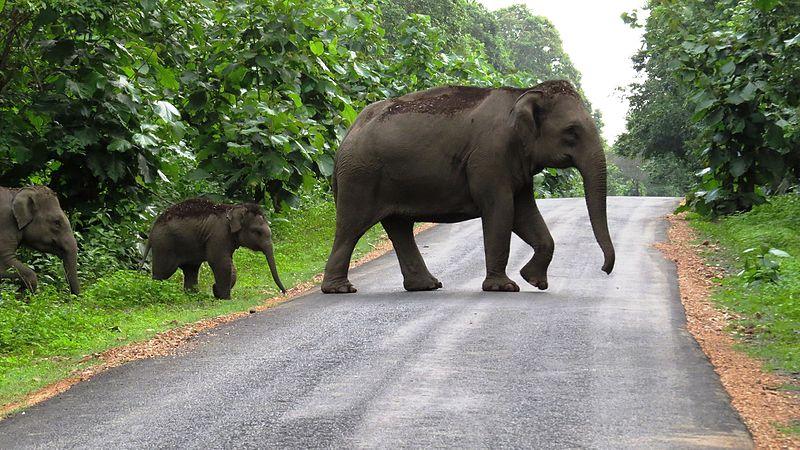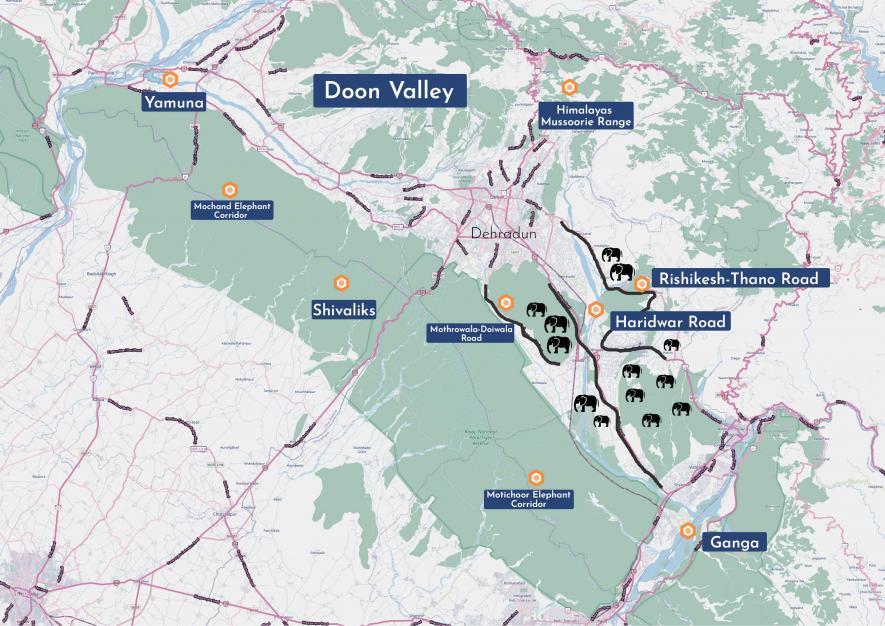Fragmented Landscapes, Destroyed Elephant Corridors

Representational Image. Image Courtesy: Wikimedia Commons
For the last three years, a herd of elephants has been stuck in the Timli area of the Shivalik hills in Uttarakhand, near Paonta Sahib on the state’s border with Himachal Pradesh. The large number of roads being built or widened around Timli, including the Asarodhi to Jhajra outer ring road and the Vikasnagar-Behat road, apart from the illegal occupation of large tracts of forest land for human settlements, have made it practically impossible for this herd to move.
This is the situation in many so-called elephant corridors in and around the Shivalik, home to the nomadic elephants. This is another reality check for the government and forest departments around the country, who are celebrating Gaj Utsav, or Elephant Festival, with pomp and show on Friday.
The elephant and its large-scale movement are tied closely to seasonal variations in rainfall. They are always on the move in search of food and water, but hindrances in their path result in stress and aggressive behaviour. Environmental scientists warn about increased extinction risks and risks to humans from conflict with animals whose habitats and movements are threatened.
When asked how he expects to resolve the issue, the Mussoorie District Forest Officer, Ashutosh Singh, under whose jurisdiction Timli falls, said, “They [the elephants] will have to be translocated from there. Some alternative plan has to be worked out for this herd.”
Traditional elephant movement between the Ganga-Yamuna river basins, extending from Paonta Sahib to Rishikesh and Haridwar to Nepal, has stopped because of increased human encroachment for agricultural purposes, settlements, and wasteful infrastructure projects in the name of development.
From the 4,000 elephants that used to live in the Shivalik range just a few decades ago, the population is now down to 2,000. Environmentalists warn that this will fall further if their movement corridors do not get legal protection, similar to the tiger, to prevent rapid habitat fragmentation. Elephant specialist Dr A Christy Williams, a member of the Asian Elephant Specialist Group, has spent several years studying elephants at the Rajaji National Park and in the Shivalik region. He believes the elephant count in this region already does not exceed 1,000.
However, legal protection is far from the ground reality. The main culprits for the steady erosion of forest corridors in Uttarakhand are its politicians, who show little to no environmental sensitivity.
A recent visit to the elephant corridor between Raipur and Bhopalpani on the outskirts of Dehradun showed that it comprises a large stretch of low-lying marshy land, which becomes a wetland during the monsoon season. The Song River flows close by. Across the road are large stretches of solar fencing installed by the forest department to ensure elephants cannot cross over.
Officials of the State Property Department said the Forest Department received Rs 7 crore to transfer this land to construct a new Assembly Secretariat building. Another Rs 15.37 crore will be given to the Forest Department for the elephant corridor. The Vidhan Sabha will cost Rs 500 crore to construct.
Environmental activist Reenu Paul says, “Once this crucial elephant corridor gets destroyed, what use is this money to these animals? Conversion of natural areas for human use impacts the ecosystem and its functioning, thereby threatening the entire ecosystem.”
Environmentalists also question the state government’s green signal to construct the new Assembly building, given hundreds of crores have been sunk into building a Vidhan Sabha and a warren of government buildings in Dehradun. The state government has decided to make a summer capital in Gairsain, on which several hundred crores have already been spent to build a new Vidhan Sabha. Where was the need for a third building?
The state government explains that it is done to decongest the city.
Says DFO Ashutosh Singh, “This was an executive decision taken at the highest level.” The inability of Uttarakhand’s Forest Department to stand up to executive fiats is the main reason why prime forest land is getting lost at this rapid pace.
When prime minister Narendra Modi visited Dehradun in 2021, an IAS officer had a road built overnight, cutting through the forest. The road was built without clearance from the Forest Department and is today used by trucks, taxis, and other vehicular movements.

The road built in 2021 for the PM's visit. (Clicked on March 28, 2023) | Images by Rashme Sehgal
Road construction within a forest area opens it up for illegal settlements, and in the last two years, several structures have come up in and around the Thano forest, 15 kilometres from Dehradun city, blocking the movement of herds of elephants.
The last straw on the elephant’s back was the announcement that the state government is again looking at expanding the Jolly Grant Airport by transferring 250 acres of prime forest land in the Thano forest range, even though they are fully aware that this will adversely impact elephant movement.
This area lies within a 10-km radius of the Rajaji National Park Eco-Sensitive Zone.
Three years ago, when the state government had first proposed airport expansion, Paul had filed a Public Interest Litigation in the Nainital High Court against it. Her petition highlighted it would require felling over 10,000 trees. The High Court stayed the construction, and the state government withdrew the petition and, in October 2022, restored the Shivalik elephant corridor. It also agreed to expand the airport towards the densely-populated Bhaniyawala colony.
This Shivalik elephant reserve spread over 5,000 sq km was notified in 2002 under Project Elephant, launched by the government of India in 1992. The airport expansion had seen massive protests by the public.
Senior state government officials have again expressed confidence that soon they can expand the airport towards the Thano forest. No official announcement has been made, but the Uttarakhand state government received Rs 1.5 lakh crore as part of its annual budget from the Centre for infrastructure development. Most of this money is being spent on road widening and construction, often with roads being duplicated and triplicated in forest areas.
Areas that form part of the constituency of former chief minister Trivendra Singh Rawat are part of these expanding construction plans. Political analyst SMA Kazmi based in Dehradun, believes, “The voters of Bhaniyawala form a key part of his constituency, and he does not want to lose this crucial vote bank.”
Another lost critical corridor stretches from Mohand, accessed by road from Chutmalpur in Saharanpur, Uttar Pradesh, which ends at the Rajaji Tiger Sanctuary. The Union Ministry of Road and Transport and Highways pushed through the construction of the Delhi-Dehradun Expressway, requiring the construction of a 12-km elevated corridor close to the Rajaji reserve. The expressway is a duplicate of the existing National Highway-58 that runs from Ghaziabad in Uttar Pradesh to Badrinath in Uttarakhand.

Doon Valley and its elephant corridors. Illustration for representational purposes only.
Excessive construction is not only eroding the Shivalik ecosystem but destroying a large number of rivers and springs that emanate from this area.
Rajeev Mehta, former honorary wildlife warden at Rajaji, says, “This blockage of elephant corridors is intensifying human-animal conflict because their search for water brings them closer to human habitation.”
Villagers see increased cases of elephant electrocution with the indiscriminate use of solar fencing by forest authorities and the illegal use of electric fences.
When tuskers’ corridors get blocked, they attack people and damage standing crops, as seen in Balawala and Raiwala, located just outside the Dehradun city limits.
Forest Ranger NL Dobhal, who heads the Thano forest range, emphasises how the thrust of the Indian Forest Service cadre was to keep their political masters and the local population satisfied, even at the cost of the animals.
Mehta cites several examples when elephants have not hesitated to bring down walls in the way of their migration.
He also pointed out how elephants can travel to great lengths while searching for clean drinking water. Elephants do not drink polluted water. “There are 800 Gujjar families presently settled in the Shayampur Range in the Haridwar division of the Rajaji park. They were given only grazing rights. Earlier, the government had a successful rehabilitation policy to rehabilitate them by giving Rs 5 lakh per family and five bighas of land. It started in 2004 but has stopped under the current BJP regime,” he says. As a result, thousands of water buffaloes bathe and urinate in the flowing rivers of the reserve. “We have found that elephants prefer to go thirsty but will not drink polluted water. Sadly, the rivers flowing through Dehradun are now full of sewage, and hence elephants need to move greater distances to find clean water,” he says.
The dwindling population of wild elephants is not an issue of political significance, but an escalation in cases of human-elephant conflicts will invariably see the elephant emerge as the loser.
The author is an independent journalist. The views are personal.
Get the latest reports & analysis with people's perspective on Protests, movements & deep analytical videos, discussions of the current affairs in your Telegram app. Subscribe to NewsClick's Telegram channel & get Real-Time updates on stories, as they get published on our website.
























